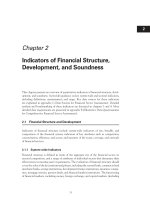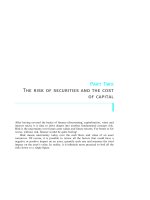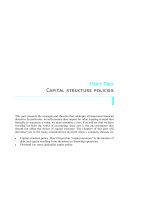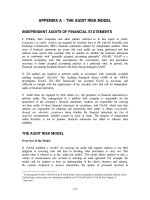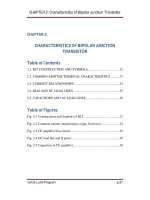Chapter 2: Selection of Independent Auditors_part2 pdf
Bạn đang xem bản rút gọn của tài liệu. Xem và tải ngay bản đầy đủ của tài liệu tại đây (97.87 KB, 11 trang )
Nonetheless, MCC and the recipient need reliable information to monitor actual cost-sharing
contributions throughout the life of the agreement.
4.11 Thus, for agreements with a life-of-project budget for cost-sharing contributions, for each year
that an audit is performed in accordance with these Guidelines, the auditors will review the cost-
sharing schedule to determine if the schedule is fairly presented in accordance with the basis of
accounting used by the recipient to prepare the schedule. The auditors must question all cost-
sharing contributions that are either ineligible or unsupported costs. An ineligible cost is a cost that
is unreasonable, prohibited by the agreements or applicable laws and regulations, or is not program
related. An unsupported cost lacks adequate documentation or does not have required prior
approvals or authorizations. All questioned costs must be briefly described in the notes to the cost-
sharing schedule. In addition, material questioned costs must be included as findings in the report
on compliance. Notes to the cost-sharing schedule must be cross-referenced to the corresponding
findings in the report on compliance. Also, reportable internal control weaknesses related to cost-
sharing contributions must be set forth as findings in the report on internal control. (See sample
cost-sharing schedule at Example 6.2.A, and sample reports at Examples 7.6.A and 7.6.B of these
Guidelines.)
4.12 In addition, for closeout audits of agreements with a life-of-project budget for cost-sharing
contributions, the auditors will review the cost-sharing schedule to determine if the recipients
provided such contributions in accordance with the terms of the agreement. If actual contributions
were less than budgeted contributions, the shortfall will be identified in the appropriate column of
the cost-sharing schedule. (See sample cost-sharing schedule at Example 6.2.B, and sample reports
at Examples 7.6.C and 7.6.D of these Guidelines.)
Agreement with Annual Cost-Sharing Budget
4.13 For agreements with an annual budget for cost-sharing contributions, for each year that an
audit is performed in accordance with these Guidelines, the auditors will review the cost-sharing
schedule to determine whether (1) the schedule is fairly presented in accordance with the basis of
accounting used by the recipient to prepare the cost-sharing schedule and (2) contributions were
provided by the recipient in accordance with the terms of the agreement. The auditors must question
all cost-sharing contributions that are either ineligible or unsupported costs. An ineligible cost is
unreasonable, prohibited by the agreements or applicable laws and regulations, or not program
related. An unsupported cost lacks adequate documentation or does not have required prior
approvals or authorizations. All questioned costs must be briefly described in the notes to the cost-
sharing schedule. In addition, material questioned costs must be included as findings in the report
on compliance. Notes to the cost-sharing schedule must be cross-referenced to the corresponding
findings in the report on compliance. Also, reportable internal control weaknesses related to cost-
sharing contributions must be set forth as findings in the report on internal control. If actual cost-
sharing contributions were less than budgeted contributions, the shortfall will be identified in the
appropriate column of the cost-sharing schedule. (See sample cost-sharing schedule at Example
6.2.B, and sample reports at Examples 7.6.C and 7.6.D of these Guidelines.)
Revised on January 2006
14
This is trial version
www.adultpdf.com
Internal Control
4.14 The auditors must review and evaluate the recipient's internal control related to MCC programs
to obtain a sufficient understanding of the design of relevant control policies and procedures and
whether those policies and procedures have been placed in operation. The U.S. General Accounting
Office's Standards for Internal Control in the Federal Government (GAO/AIMD-00-21.3.1; 1999)
may prove helpful in assessing recipient internal control. The internal control must be documented
in the working papers.
4.15 Auditors must then prepare the report required by these Guidelines, identifying the
reportable conditions that are significant deficiencies in the design or operation of internal
control, and the reportable conditions considered to be material weaknesses. Material
weaknesses are reportable conditions in which the design or operation of the specific internal
control elements do not reduce to a relatively low level the risk that errors or fraud in amounts
that would be material in relation to the fund accountability statement may occur and not be
detected in a timely manner by management performing its normal functions. Reportable
conditions, including material weaknesses, must be set forth in the report as "findings" (see
paragraph 5.1.d of these Guidelines). Reportable conditions involve matters coming to the
auditor’s attention relating to significant deficiencies in the design or operation of internal
control that, in the auditor’s judgment, could adversely affect the recipient's ability to record,
process, summarize, and report financial data consistent with the assertions of management in
the fund accountability statement and cost-sharing schedule. Nonreportable conditions should be
included in a separate management letter to the recipient and referred to in the report on internal
control.
4.16 The major internal control components to be studied and evaluated include, but are not limited
to, the controls related to each revenue and expense account on the fund accountability statement.
The auditors must:
a. Obtain a sufficient understanding of internal control to plan the audit and to determine the
nature, timing and extent of tests to be performed.
b. Assess inherent risk and control risk, and determine the combined risk. Inherent risk is the
susceptibility of an assertion, such as an account balance, to a material misstatement assuming
there are no related internal control policies or procedures. Control risk is the risk that a
material misstatement that could occur in an assertion will not be prevented or detected in a
timely manner by the entity’s internal control policies or procedures. Combined risk
(sometimes referred to as detection risk) is the risk that the auditor will not detect a material
misstatement that exists in an assertion. Combined risk is based upon the effectiveness of an
auditing procedure and the auditor’s application of that procedure.
c. Summarize the risk assessments for each assertion in a working paper. The risk assessments
should consider the following broad categories under which each assertion should be classified:
(a) existence or occurrence; (b) completeness; (c) Rights and obligations; (d) valuation or
allocation; and (e) presentation and disclosure. At a minimum, the working papers should
identify the name of the account or assertion, the account balance or the amount represented by
the assertion, the assessed level of inherent risk (high, moderate, or low), the assessed level of
Revised on January 2006
14
This is trial version
www.adultpdf.com
control risk (high, moderate, or low), the combined risk (high, moderate, or low), and a
description of the nature, timing and extent of the tests performed based on the combined risk.
These summary working papers should be cross-indexed to the supporting working papers that
contain the detailed analysis of the fieldwork. If control risk is evaluated at less than the
maximum level (high), then the basis for the auditor’s conclusion must be documented in the
working papers.
c.1 If the auditors assess control risk at the maximum level for assertions related to material
account balances, transaction classes, and disclosure components of financial statements when
such assertions are significantly dependent upon computerized information systems, the
auditors must document in the working papers the basis for such conclusions by addressing (i)
the ineffectiveness of the design and/or operation of controls, or (ii) the reasons why it would
be inefficient to test the controls.
d. Evaluate the control environment, the adequacy of the accounting systems, and control
procedures. Emphasize the policies and procedures that pertain to the recipient’s ability to
record, process, summarize, and report financial data consistent with the assertions embodied in
each account of the fund accountability statement. This should include, but not be limited to,
the control systems for:
d.1 Ensuring that charges to the program are proper and supported.
d.2 Managing cash on hand and in bank accounts.
d.3 Procuring goods and services.
d.4 Managing inventory and receiving functions.
d.5 Managing personnel functions such as timekeeping, salaries and benefits.
d.6 Managing and disposing of commodities (such as supplies, materials, vehicles,
equipment, food products, tools, etc.) purchased either by the recipient or directly by MCC
or the MCA.
d.7 Ensuring compliance with agreement terms and applicable laws and regulations that
collectively have a material impact on the fund accountability statement. Specifically,
evaluate compliance with the Procurement Agreement and Procurement Guidelines as well
as the Fiscal Accountability Plan. The results of this evaluation should be contained in the
working paper section described in paragraphs 4.18 thorough 4.20.k of these Guidelines and
presented in the compliance report.
e. Evaluate internal control established to ensure compliance with cost-sharing requirements, if
applicable, including both provision and management of the contributions.
f. Include in the study and evaluation other policies and procedures that may be relevant if they
pertain to data the auditors use in applying auditing procedures. This may include, for example,
Revised on January 2006
14
This is trial version
www.adultpdf.com
policies and procedures that pertain to non-financial data that the auditors use in analytical
procedures.
4.17 In fulfilling the audit requirement relating to an understanding of internal control and assessing
the level of control risk, the auditor must follow, at a minimum, the guidance contained in AICPA
SAS Nos. 55, 60, and 78 (AU110, AU319, AU324 and AU325), respectively entitled Consideration
of Internal Control in a Financial Statement Audit, Communication of Internal Control Related
Matters Noted in an Audit, and Consideration of Internal Control in a Financial Statement Audit:
An Amendment to Statement on Auditing Standards No. 55, as well as SAS No. 74 (AU801) entitled
Compliance Auditing Considerations in Audits of Governmental Entities and Recipients of
Governmental Financial Assistance.
Compliance with Agreement Terms and Applicable Laws and Regulations
4.18 In fulfilling the audit requirement to determine compliance with agreement terms and
applicable laws and regulations related to MCC programs, the auditors must, at a minimum, follow
guidance contained in AICPA SAS No. 74 (AU801) entitled Compliance Auditing Considerations
in Audits of Governmental Entities and Recipients of Governmental Financial Assistance. The
compliance review must also determine—on audits of awards that present cost-sharing budgets on
an annual basis and on close-out audits of awards that present cost-sharing budgets on a life-of-
project basis—if cost-sharing contributions were provided and accounted for in accordance with the
terms of the agreements. The auditor's report on compliance must set forth as findings all material
instances of noncompliance, defined as instances that could have a direct and material effect on the
fund accountability statement. Nonmaterial instances of noncompliance should be included in a
separate management letter to the recipient and referred to in the report on compliance.
4.19 The auditor’s report should include all conclusions that a fraud or illegal act either has occurred
or is likely to have occurred. In reporting material fraud, illegal acts, or other noncompliance, the
auditors should place their findings in proper perspective. To give the reader a basis for judging the
prevalence and consequences of these conditions, the instances identified should be related to the
universe or the number of cases examined and is quantified in terms of U.S. dollars, if appropriate.
In presenting material fraud, illegal acts, or other noncompliance, auditors must follow the reporting
standards contained in Chapter 5 of U.S. Government Auditing Standards. Auditors may provide
less extensive disclosure of fraud and illegal acts that are not material in either a quantitative or
qualitative sense. Chapter 4 of
U.S. Government Auditing Standards discusses factors that may
influence auditors’ materiality judgments. If the auditors conclude that sufficient evidence of fraud
or illegal acts exists, they must contact the OIG office and exercise due professional care in
pursuing indications of possible fraud and illegal acts to avoid interfering with potential future
investigations or legal proceedings.
4.20 In planning and conducting the tests of compliance the auditors must:
a. Identify the agreement terms and pertinent laws and regulations and determine which of
those, if not observed, could have a direct and material effect on the fund accountability
statement. Special attention should be given to the Procurement Agreement and Procurement
Guidelines as well as the Fiscal Accountability Plan. The auditors must:
Revised on January 2006
14
This is trial version
www.adultpdf.com
a.1 List all standard and program-specific provisions contained in the agreements that
cumulatively, if not observed, could have a direct and material effect on the fund
accountability statement.
a.2 Assess the inherent and control risk that material noncompliance could occur for each of
the compliance requirements listed in paragraph a.1 above.
a.3 Determine the nature, timing and extent of audit steps and procedures to test for errors,
fraud, and illegal acts that provide reasonable assurance of detecting both intentional and
unintentional instances of noncompliance with agreement terms and applicable laws and
regulations that could have a material effect on the fund accountability statement. This
should be based on the risk assessment described in paragraph a.2 above.
a.4 Prepare a summary working paper that identifies each of the specific compliance
requirements included in the review, the results of the inherent, control and combined
(detection) risk assessments for each compliance requirement, the audit steps used to test for
compliance with each of the requirements based on the risk assessment, and the results of
the compliance testing for each requirement. The summary working paper should be cross-
indexed to detailed working papers that support the facts and conclusions contained in the
summary working paper.
b. Determine if payments have been made in accordance with agreement terms and applicable
laws and regulations.
c. Determine if funds have been expended for purposes not authorized or not in accordance with
applicable agreement terms. If so, the auditors must question these costs in the fund
accountability statement.
d. Identify any costs not considered appropriate, classifying and explaining why these costs are
questioned.
e. Determine whether commodities, whether procured by the recipient or directly procured by
MCC or MCA for the recipient's use, exist or were used for their intended purposes in
accordance with the terms of the agreements. If not, the cost of such commodities must be
questioned.
f. Determine whether any technical assistance and services, whether procured by the recipient or
directly procured by MCC for the recipient's use, were used for their intended purposes in
accordance with the agreements. If not, the cost of such technical assistance and services should
be questioned.
g. Determine if the amount of cost-sharing funds was calculated and accounted for as required
by the agreements or applicable cost principles.
Revised on January 2006
27
This is trial version
www.adultpdf.com
h. Determine if the cost-sharing funds
5
were provided according to the terms of the agreements
and quantify any shortfalls.
i. Determine whether those who received services and benefits were eligible to receive them.
j. Determine whether the recipient’s financial reports (including those on the status of cost-
sharing contributions) and claims for advances and reimbursement contain information that is
supported by the books and records.
k. Determine whether the recipient held advances of MCC or MCA funds in interest-bearing
accounts, and whether the recipient remitted to MCC or MCA any interest earned on those
advances.
Follow-Up on Prior Audit Recommendations
4.21 The auditors must review the status of actions taken on findings and recommendations reported
in prior audits of MCC-funded programs. Chapter 4 of U.S. Government Auditing Standards, under
the section entitled Audit Follow-up, states: "Auditors must follow up on known material findings
and recommendations from previous audits that could affect the financial statement audit. They do
this to determine whether the auditee has taken timely and appropriate corrective actions. Auditors
must report the status of uncorrected material finding and recommendations from prior audits that
affect the financial statement audit.”
4.22 The auditors must review and report on the status of actions taken on prior findings and
recommendations in the summary section of the audit report. The auditors should refer to the
most recent recipient contracted audit report for the same award (for a follow-up audit) or other
MCC or MCA awards (for an initial audit). When corrective action has not been taken and the
deficiency remains unresolved for the current audit period and is reported again in the current
report, the auditors need to briefly describe the prior finding and status and show the page reference
to where it is included in the current report. If there were no prior findings and recommendations,
the auditors must include a note to that effect in this section of the audit report.
On audits of awards that present cost-sharing budgets on an annual basis and for closeout audits of awards that
present cost-sharing budgets on a life-of-project basis, as explained in paragraphs 4.12 and 4.13 of these Guidelines.
Revised on January 2006
28
5
This is trial version
www.adultpdf.com
General Purpose Financial Statements
4.23 Auditors should examine the recipient’s general purpose financial statements on an
organization-wide basis if an indirect cost rate needs to be audited,
6
or if the MCC or the MCA
specifically requests that the general purpose financial statements be audited. The audit must be
performed in accordance with generally accepted auditing standards of the American Institute of
Certified Public Accountants (AICPA).
4.24 The objective of this audit is to express an opinion on whether those statements present fairly,
in all material respects, the recipient's financial position at year-end, and the results of its operations
and cash flow for the year then ended, in conformity with generally accepted accounting principles.
Indirect Cost Rates
4.25 Auditors should determine the actual indirect cost rates for the year if the recipient has used
provisional rates to charge indirect costs to MCC or MCA. The audit of the indirect cost rates
should include tests to determine whether the:
a. Distribution or allocation base includes all costs that benefited from indirect activities.
b. Distribution or allocation base is in compliance with the governing MCC or MCA Negotiated
Indirect Cost Rate Agreement, if applicable.
c. Indirect cost pool includes only costs authorized by the MCC or MCA agreements and
applicable cost principles.
d. Indirect cost rates obtained by dividing the indirect cost pool by the base are accurately
calculated.
e. Costs included in this calculation reconcile with the total expenses shown in the recipient's
audited general purpose financial statements.
4.26 The results of the audit of the indirect cost rate should be presented in a schedule of
computation of indirect cost rate (see Example 6.3 of these Guidelines). This schedule should
contain: (1) a listing of costs included in each indirect cost pool, (2) the distribution base, and (3) the
resultant indirect cost rate calculation. The costs in the schedule should reconcile with the total
expenses shown in the recipient's general purpose financial statements. U.S. Office of Management
and Budget (OMB) Circular A-122 provides additional guidance on allocation of indirect costs and
determination of indirect cost rates.
6
Where indirect costs are authorized, an audit of the general purpose financial statements is needed to ensure that
all costs have been correctly included in the indirect cost rate calculation.
Revised on January 2006
29
This is trial version
www.adultpdf.com
Other Audit Responsibilities
4.27 The auditors must perform the following steps:
a. Hold entrance and exit conferences with the recipient. The OIG and the cognizant MCA
should be notified of these conferences in order that MCC representatives may attend, if deemed
necessary.
b. During the planning stages of an audit, communicate information to the auditee regarding the
nature and extent of planned testing and reporting on compliance with laws and regulations and
internal control over financial reporting. Such communication should state that the auditors do
not plan to provide opinions on compliance with laws and regulations and internal control over
financial reporting.
7
Written communication is preferred. Auditors should document the
communication in the working papers.
c. Institute quality control procedures to ensure that sufficient competent evidence is obtained
through inspection, observation, inquiries, and confirmations to afford a reasonable basis for an
opinion regarding the financial statements under audit. While auditors may use their standard
procedures for ensuring quality control, those procedures must, at a minimum, ensure that:
c.1 Audit reports and supporting working papers are reviewed by an auditor, preferably at
the partner level, who was not involved in the audit. This review must be documented.
c.2 All quantities and monetary amounts involving calculations are footed and cross-footed.
c.3 All factual statements, numbers, conclusions and monetary amounts are cross-indexed to
supporting working papers.
d. Ascertain whether the recipient ensured that audits of its subrecipients were performed to
ensure accountability for MCC funds passed through to subrecipients. If subrecipient audit
requirements were not met, the auditors should disclose this in the fund accountability statement
and consider qualifying their opinion.
e. Obtain a management representation letter in accordance with AICPA SAS No. 85 (AU333)
signed by the recipient’s management. See Example 4.1 for an illustrative management
representation letter.
Reference Materials
4.28 U.S. Government Auditing Standards may be obtained through the Internet at
/> or from the U.S. Government Printing Office, at
, by mail from Information Dissemination (Superintendent of
7
The auditors only express an opinion on the fund accountability statement, and the indirect cost rate and general
purpose financial statements, if applicable, as indicated on Chapter 3 of these Guidelines.
Revised on January 2006
30
This is trial version
www.adultpdf.com
Documents), P.O. Box 371954, Pittsburgh, PA 15250-7954, or by telephone. The order desk
telephone number is (202) 512-1800 or 866 512-1800-
4.29 Office of Management and Budget (OMB) Circulars. The following circulars can be obtained
through the OMB Internet address.
a. OMB Circular A-50 Audit Follow-up
b. Reference MCC Cost Principles
4.30 The following sections of the American Institute of Certified Public Accountants (AICPA)
Codification of Statements on Auditing Standards (SASs) may be applicable to audits of MCC
funds. The AICPA Codification of SASs may be obtained from the AICPA, 1211 Avenue of the
Americas, New York, New York 10036-8775, or at The order
department telephone number is (201) 938-3333. The audit objectives will dictate which SAS
numbers apply.
SAS NO. AU SECTION
8 Other Information in Documents Containing Audited Financial Statements 550
12 Inquiry of a Client's Lawyer Concerning Litigation, Claims, and Assessments 337
22 Planning and Supervision 311
26 Association with Financial Statements 504
29 Reporting on Information Accompanying the Basic Financial Statements
In Auditor-Submitted Documents 551
31 Evidential Matter 326
32 Adequacy of Disclosure in Financial Statements 431
39 Audit Sampling 350
42 Reporting on Condensed Financial Statements and Selected Financial Data 552
47 Audit Risk and Materiality in Conducting an Audit 312
50 Reports on the Application of Accounting Principles 625
51 Reporting on Financial Statements Prepared for Use in Other Countries 534
54 Illegal Acts by Clients 317
55 Consideration of Internal Control in a Financial Statement Audit
(Amended by SAS No. 78) 319
56 Analytical Procedures 329
Revised on January 2006
33
This is trial version
www.adultpdf.com
57 Auditing Accounting Estimates 342
58 Reports on Audited Financial Statements
(Amended by SAS No. 79) 508
60 Communication of Internal Control Related Matters Noted in an Audit 325
62 Special Reports 623
65 The Auditor's Consideration of the Internal Audit Function in an Audit of
Financial Statements 322
70 Reports on the Processing of Transactions by Service Organizations 324
71 Interim Financial Information 722
73 Using the Work of a Specialist 336
74 Compliance Auditing Considerations in Audits of Governmental Entities and
Recipients of Governmental Financial Assistance 801
75 Engagements to Apply Agreed-Upon Procedures to Specified Elements,
Accounts, or Items of a Financial Statements 622
77 Amendments to SAS No. 22, Planning and Supervision, No. 59, The Auditor's
Consideration of an Entity's Ability to Continue as a Going Concern, and No. 62,
Special Report 311, 341, 544 and 623
78 Consideration of Internal Control in a Financial Statement Audit: An
Amendment to SAS No. 55 110, 319, 324 and 325
79 Amendment to SAS No. 58, Reports on Audited Financial Statements 508
85 Management Representations (Amended by SAS No. 99) 333; 333A, and 508
87 Restricting the Use of an Auditor’s Report 325, 532 and 622
96 Audit Documentation…………………………………………………………………………………….…339
99 Consideration of Fraud in a Financial Statement Audit 230, 316 and 333
Revised on January 2006
14
This is trial version
www.adultpdf.com
Example 4.1 - Illustrative Management Representation Letter
(Date)
XYZ & CO. (Independent Auditor)
Address of Independent Auditor
We are providing this letter in connection with your audit(s) of the (identification of financial statements) of (name
of entity) as of (dates) and for the (periods) for the purpose of expressing an opinion as to whether the (consolidated)
financial statements present fairly, in all material respects, the financial position, results of operations, and cash
flows of (name of entity) in conformity with accounting principles generally accepted in the United States of
America. We confirm that we are responsible for the fair presentation in the (consolidated) financial statements of
financial position, results of operations, and cash flows in conformity with generally accepted accounting principles.
Certain representations in this letter are described as being limited to matters that are material. Items are considered
material, regardless of size, if they involve an MCA or misstatement of accounting information that, in the light of
surrounding circumstances, makes it possible that the judgment of a reasonable person relying on the information
would be changed or influenced by the MCA or misstatement.
We confirm, to the best of our knowledge and belief, (as of date of auditor's report), the following representations
made to you during your audit(s).
1. The financial statements referred to above are fairly presented in conformity with accounting principles
generally accepted in the United States of America.
2. We have made available to you all:
a. Financial records and related data.
b. Minutes of the meetings of stockholders, directors, and committees of directors, or summaries of actions
of recent meetings for which minutes have not yet been prepared.
3. There have been no communications from regulatory agencies concerning non-compliance with or deficiencies
in financial reporting practices.
4. There are no material transactions that have not been properly recorded in the accounting records underlying
the financial statements.
5. We believe that the effects of the uncorrected financial statement misstatements summarized in the
accompanying schedule are immaterial both individually and in the aggregate, to the financial statements taken
as a whole.
6. We acknowledge our responsibility for the design and implementation of programs and controls to prevent and
detect fraud.
7. We have no knowledge of any fraud or suspected fraud affecting the entity involving (a) management, (b)
employees who have significant roles in internal controls, or (c) others where the fraud could have a material
effect on the financial statements.
8. We have no knowledge of any allegations of fraud or suspected fraud affecting the entity received in
communications from employees, former employees, analysts, regulators, or others.
Revised on January 2006
34
This is trial version
www.adultpdf.com
